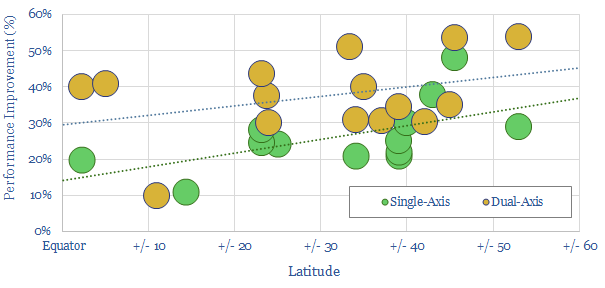This data-file quantifies solar trackers’ efficiency improvements. Depending on location, 40-90% of new utility-scale solar plants are being fitted with ‘trackers’ in the early-2020s; constantly re-positioning panels to face the sun, as it arcs across the sky, and as this arc varies season-by-season, due to the 23.5-degree tilt of the Earth on its axis of rotation.
Depending on the installation, trackers will typically add $0.1-1.0W to total costs, with a good ballpark estimate being a $0.2/W or c20% cost increase for utility-scale systems.
These trackers earn their keep by increasing productivity by 20-40% compared with fix-tile systems, which is quantified in this data-file, by aggregating the details from c30 technical papers and other sources.
A good rule of thumb is that a single-axis tracker adds 15% plus 0.35% per degree of latitude; while a dual-axis tracker adds 30% plus 0.25% per degree of latitude.
Latitude matters because the further a location is from the equator, the more variably the sun will arc across the sky in different seasons, especially during the summer solstice (worked examples are given in the data-file), comparing London, Singapore and Estonia, based on an excellent online resource here.
Solar trackers’ efficiency improvements are not evenly spaced throughout the year; performance additions may be around 40-50% higher in summer and c10-20% in the winter, versus typical fixed or horizontal baselines.
One of the leading providers of solar tracker systems is Array Technologies, assessed in our patent review here.
